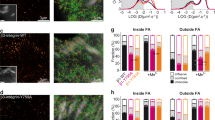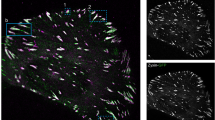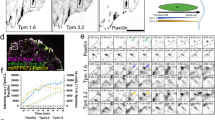Abstract
Cell adhesions to the extracellular matrix (ECM) are necessary for morphogenesis, immunity and wound healing1,2. Focal adhesions are multifunctional organelles that mediate cell–ECM adhesion, force transmission, cytoskeletal regulation and signalling1,2,3. Focal adhesions consist of a complex network4 of trans-plasma-membrane integrins and cytoplasmic proteins that form a <200-nm plaque5,6 linking the ECM to the actin cytoskeleton. The complexity of focal adhesion composition and dynamics implicate an intricate molecular machine7,8. However, focal adhesion molecular architecture remains unknown. Here we used three-dimensional super-resolution fluorescence microscopy (interferometric photoactivated localization microscopy)9 to map nanoscale protein organization in focal adhesions. Our results reveal that integrins and actin are vertically separated by a ∼40-nm focal adhesion core region consisting of multiple protein-specific strata: a membrane-apposed integrin signalling layer containing integrin cytoplasmic tails, focal adhesion kinase and paxillin; an intermediate force-transduction layer containing talin and vinculin; and an uppermost actin-regulatory layer containing zyxin, vasodilator-stimulated phosphoprotein and α-actinin. By localizing amino- and carboxy-terminally tagged talins, we reveal talin’s polarized orientation, indicative of a role in organizing the focal adhesion strata. The composite multilaminar protein architecture provides a molecular blueprint for understanding focal adhesion functions.
This is a preview of subscription content, access via your institution
Access options
Subscribe to this journal
Receive 51 print issues and online access
$199.00 per year
only $3.90 per issue
Buy this article
- Purchase on Springer Link
- Instant access to full article PDF
Prices may be subject to local taxes which are calculated during checkout




Similar content being viewed by others
References
Burridge, K. & Chrzanowska-Wodnicka, M. Focal adhesions, contractility, and signaling. Annu. Rev. Cell Dev. Biol. 12, 463–518 (1996)
Geiger, B., Bershadsky, A., Pankov, R. & Yamada, K. M. Transmembrane crosstalk between the extracellular matrix-cytoskeleton. Nature Rev. Mol. Cell Biol. 2, 793–805 (2001)
Bershadsky, A. D., Balaban, N. Q. & Geiger, B. Adhesion-dependent cell mechanosensitivity. Annu. Rev. Cell Dev. Biol. 19, 677–695 (2003)
Zaidel-Bar, R. et al. Functional atlas of the integrin adhesome. Nature Cell Biol. 9, 858–867 (2007)
Franz, C. M. & Muller, D. J. Analyzing focal adhesion structure by atomic force microscopy. J. Cell Sci. 118, 5315–5323 (2005)
Chen, W. T. & Singer, S. J. Immunoelectron microscopic studies of the sites of cell-substratum and cell-cell contacts in cultured fibroblasts. J. Cell Biol. 95, 205–222 (1982)
Wang, Y. L. Flux at focal adhesions: slippage clutch, mechanical gauge, or signal depot. Sci. STKE 2007, pe10 (2007)
Lauffenburger, D. A. & Horwitz, A. F. Cell migration: a physically integrated molecular process. Cell 84, 359–369 (1996)
Shtengel, G. et al. Interferometric fluorescent super-resolution microscopy resolves 3D cellular ultrastructure. Proc. Natl Acad. Sci. USA 106, 3125–3130 (2009)
Palade, G. E. & Porter, K. R. Studies on the endoplasmic reticulum. I. Its identification in cells in situ . J. Exp. Med. 100, 641–656 (1954)
Ledbetter, M. C. & Porter, K. R. A “microtubule” in plant cell fine structure. J. Cell Biol. 19, 239–250 (1963)
Patterson, G. H. et al. Transport through the Golgi apparatus by rapid partitioning within a two-phase membrane system. Cell 133, 1055–1067 (2008)
Liu, J., Kaksonen, M., Drubin, D. G. & Oster, G. Endocytic vesicle scission by lipid phase boundary forces. Proc. Natl Acad. Sci. USA 103, 10277–10282 (2006)
Keren, K. et al. Mechanism of shape determination in motile cells. Nature 453, 475–480 (2008)
Pollard, T. D. & Berro, J. Mathematical models and simulations of cellular processes based on actin filaments. J. Biol. Chem. 284, 5433–5437 (2009)
Shroff, H. et al. Dual-color superresolution imaging of genetically expressed probes within individual adhesion complexes. Proc. Natl Acad. Sci. USA 104, 20308–20313 (2007)
Hell, S. W., Schmidt, R. & Egner, A. Diffraction-unlimited three-dimensional optical nanoscopy with opposing lenses. Nature Photon. 3, 381–387 (2009)
Betzig, E. et al. Imaging intracellular fluorescent proteins at nanometer resolution. Science 313, 1642–1645 (2006)
Wiedenmann, J. et al. a fluorescent marker protein with UV-inducible green-to-red fluorescence conversion. Proc. Natl Acad. Sci. USA 101, 15905–15910 (2004)
McKinney, S. A. et al. A bright and photostable photoconvertible fluorescent protein. Nature Methods 6, 131–133 (2009)
Mitra, S. K., Hanson, D. A. & Schlaepfer, D. D. Focal adhesion kinase: in command and control of cell motility. Nature Rev. Mol. Cell Biol. 6, 56–68 (2005)
Brown, M. C. & Turner, C. E. Paxillin: adapting to change. Physiol. Rev. 84, 1315–1339 (2004)
Galbraith, C. G., Yamada, K. M. & Sheetz, M. P. The relationship between force and focal complex development. J. Cell Biol. 159, 695–705 (2002)
Yoshigi, M. et al. Mechanical force mobilizes zyxin from focal adhesions to actin filaments and regulates cytoskeletal reinforcement. J. Cell Biol. 171, 209–215 (2005)
Otey, C. A. & Carpen, O. Alpha-actinin revisited: a fresh look at an old player. Cell Motil. Cytoskeleton 58, 104–111 (2004)
Critchley, D. R. Biochemical and structural properties of the integrin-associated cytoskeletal protein talin. Annu Rev Biophys 38, 235–254 (2009)
Hu, K. et al. Differential transmission of actin motion within focal adhesions. Science 315, 111–115 (2007)
Brown, C. M. et al. Probing the integrin-actin linkage using high-resolution protein velocity mapping. J. Cell Sci. 119, 5204–5214 (2006)
Jiang, G. et al. Two-piconewton slip bond between fibronectin and the cytoskeleton depends on talin. Nature 424, 334–337 (2003)
del Rio, A. et al. Stretching single talin rod molecules activates vinculin binding. Science 323, 638–641 (2009)
Dulkeith, E. et al. Plasmon emission in photoexcited gold nanoparticles. Phys. Rev. B 70, 205424 (2004)
Press, W. H., Flannery, P. P., Teukolsky, S. A. & Vetterling, W. T. Numerical Recipes (Cambridge Univ. Press, 1986)
Thompson, R. E., Larson, D. R. & Webb, W. W. Precise nanometer localization analysis for individual fluorescent probes. Biophys. J. 82, 2775–2783 (2002)
Aubin, J. E. Autofluorescence of viable cultured mammalian cells. J. Histochem. Cytochem. 27, 36–43 (1979)
Zamir, E. et al. Molecular diversity of cell-matrix adhesions. J. Cell Sci. 112, 1655–1669 (1999)
Acknowledgements
We thank J. Lippincott-Schwartz, G. Patterson and M. Parsons for sharing DNA; S. Xie for help with automation software; K. Jaqaman for MATLAB code; and HHMI Janelia Farm Scientific Computing and NIH Helix systems for computing resources. Funding: Division of Intramural Research, NHLBI (P.K., A.M.P. and C.M.W.); Howard Hughes Medical Institute (G.S. and H.F.H.).
Author information
Authors and Affiliations
Contributions
P.K. and G.S. collected data and performed data analyses. G.S. and H.F.H. designed and built the instrument. A.M.P. performed immunoprecipitation and western blot experiments. E.B.R. and M.W.D. created expression constructs. P.K., C.M.W., G.S., H.F.H., M.W.D. and A.M.P. wrote the manuscript. P.K. and G.S. contributed equally to the study. All authors discussed the results and commented on the manuscript.
Corresponding authors
Ethics declarations
Competing interests
The authors declare no competing financial interests.
Supplementary information
Supplementary Information
The file contains Supplementary Figures 1-22 with legends, Supplementary Tables 1-4 and, Supplementary Notes 1-6 and additional references. (PDF 4167 kb)
Rights and permissions
About this article
Cite this article
Kanchanawong, P., Shtengel, G., Pasapera, A. et al. Nanoscale architecture of integrin-based cell adhesions. Nature 468, 580–584 (2010). https://doi.org/10.1038/nature09621
Received:
Accepted:
Published:
Issue Date:
DOI: https://doi.org/10.1038/nature09621
This article is cited by
-
Myosin-independent stiffness sensing by fibroblasts is regulated by the viscoelasticity of flowing actin
Communications Materials (2024)
-
Alteration of actin cytoskeletal organisation in fetal akinesia deformation sequence
Scientific Reports (2024)
-
pH-regulated single cell migration
Pflügers Archiv - European Journal of Physiology (2024)
-
Gravitational effects on fibroblasts’ function in relation to wound healing
npj Microgravity (2023)
-
Zyxin regulates embryonic stem cell fate by modulating mechanical and biochemical signaling interface
Communications Biology (2023)
Comments
By submitting a comment you agree to abide by our Terms and Community Guidelines. If you find something abusive or that does not comply with our terms or guidelines please flag it as inappropriate.



